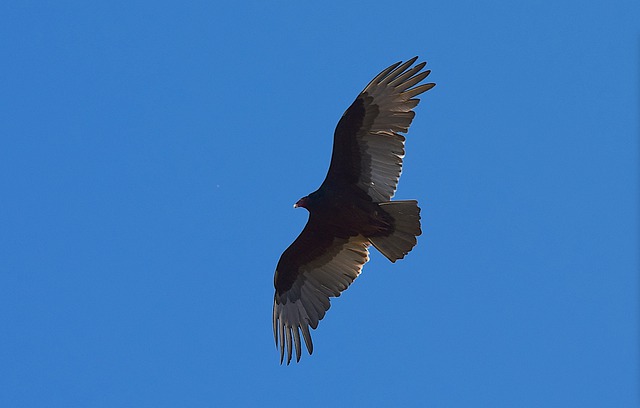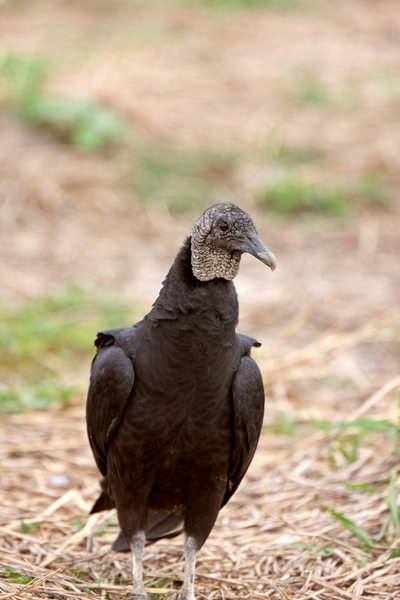Ever wonder what soars high above, silently circling on thermals and keeping a watchful eye on the land below?
They are vultures, the scavengers of the sky.
But did you know that Ontario is home to not just one, but two different types of these feathered giants?
Join us as we take a closer look at the Turkey Vulture and the Black Vulture, two vastly different species that call the province of Ontario their home.
| Image | Name |
|---|---|
 | Turkey Vulture |
 | Black Vulture |
Types of Vultures in Ontario
Although vultures lack the necessary vocal organ to sing, vultures are capable of producing a loud hiss or grunt, particularly when threatened or competing for a share of a carrion feast.
The province of Ontario is home to two of the world’s 23 vulture species.
1. Turkey Vulture

Turkey Vultures may be spotted throughout Ontario in the breeding season and appear on 20% of the summer checklist provided by bird observers in the province.
They are mostly seen in the province’s south from March through November, although some stay all year.
Turkey Vultures are appropriately called. With their large, red bald heads and upper necks, and brownish-black bodies, they certainly resemble turkeys.
They are, however, bigger than turkeys, and as they fly, their wide wings are slightly elevated and form a “V” shape.
They have grey coloration under their wings, giving the impression that they are two-toned.
Their eyes are dark brown, and their bills are generally pale in tone.
There are six subspecies of Turkey Vultures, three of which are found across North America, resulting in the reason they are frequently referred to as “Northern” Turkey Vultures.
There are just small changes between them, mostly in tail and wing dimensions and underwing feather color.
Turkey Vultures may be found in a variety of environments, although the most frequent are open and semi-open regions next to woods.
Foraging requires open spaces such as shrublands, grasslands, marshes, and deserts.
They also need woods with tall trees for breeding and roosting, as well as moderate to high altitudes, such as hills and hilly locations, to provide them a height advantage when taking flight.
They may sometimes forage and roost among farmlands or pasturelands.
When they can’t locate their preferred homes, they take over human-made buildings.
Carrion or recently deceased or rotting animals are the primary sources of food for Turkey Vultures, as long as they haven’t rotted too much.
They may feast on roadkill and fish, and they might even kill tiny or weak animals.
Turkey Vulture nests are commonly located in protected settings, such as cracks in cliffs and ancient buildings.
They could also utilize hollow trees or logs, as well as impenetrable thickets.
They do not, however, construct nests.
Normally, the female lays about 1 to 3 eggs on the earth at the nesting location.
Both parents incubate the egg for 38 to 41 days.
Turkey Vultures have a keen sense of smell and may detect aromas of rotting or dead animals on the land from vast distances.
When attacked or agitated, Turkey Vultures may vomit to divert themselves and fly away.
They also might claim to be dead.
2. Black Vulture

In Ontario, black vultures have been classified as an uncommon or incidental species; however, they have been sighted all year round in the province’s south.
The Black Vulture has a black body. They are said to be the darkest of all vultures.
Their backs, wings, belly, chests, and tails are all black, but they have silvery spots on the bottom of their wings that seem like hands as they fly.
Their eyes are brown, and their legs are grayish-white.
The head and neck of the Black Vulture are grey and featherless, resembling wrinkled skin.
Because it has to push its head into the corpses of dead animals to get to the juiciest bits, Black Vultures are “bald.”
When pieces and fragments of carrion attach to the plumage on their heads, it will be difficult to allow them to clean themselves.
The Black Vulture is sometimes known as the American Black Vulture; however, this is not its accepted term.
Its only purpose is to differentiate it from the Aegypius monachus, Eurasian Black Vulture.
Black Vultures may be found in open regions of lowland and medium altitudes.
They are often spotted in forested surroundings and roost in wooded regions near bodies of water.
Other environments include meadows, shrublands, pastures, and wetlands, and they have even been seen feeding in trash cans and waste dumps in human-occupied cities.
Black Vultures consume almost everything, but their favorite food is carrion or rotting carcasses.
They can see dead birds on the earth, but they typically depend on other predator birds to lead them to food.
They devour dead fowl ranging in size from tiny to huge, as well as snakes, coyotes, raccoons, and even floating fish.
They also destroy tiny or vulnerable animals such as lambs, newborn calves, and tortoises and spend time searching through dumpsters and landfills.
Black Vulture nests are essentially nonexistent because they do not create them.
They just deposit their eggs in areas like abandoned houses, thickets, and caverns.
They may even place them within hollow trees and stumps, reusing effective nesting locations for several years.
Female Black Vultures deposit 1 to 3 eggs, which both parents incubate for 28 to 41 days.
When they hatch, their parents feed them by regurgitation, which is when parents vomit food from their mouths into the mouths of their babies.
They can care for their babies for a maximum of eight months.
Black vultures establish strong social relationships, such as communal roosts and food sharing among families.
They are exceedingly picky about non-relatives entering the communal roosts and will fight anyone who attempts to do so.
The Black Vulture has a good sense of sight but not of smell; thus, it will follow those who do in order to obtain food.
Conclusion
Canada is a large country with a diversified landscape.
Ontario is one of the best places in the world to see birds.
A bird might well be discovered in a variety of different situations.
Water birds may be observed in gardens and parks, but you’ll have to go further into the forests to see them.
FAQ
How can you spot a vulture?
Turkey Vultures are huge blackbirds having wide, long wings. Except for eagles and condors, they are larger than other raptors and also have lengthy “fingertips” at their wingtips and long tails which reach over their toe tips during flight. When flying, Turkey Vultures elevate their wings slightly, forming a ‘V’ when seen from above.
Is it possible to see black vultures in Ontario?
In Ontario, black vultures have usually been considered uncommon or incidental species; however, they have been sighted all year in the province’s south. The Black Vulture has a black body. They are said to be the darkest of all vultures.
Which vulture is the largest?
The cinereous vulture, sometimes known as the black vulture, is among the biggest flying birds. According to several biologists, this bird is the biggest vulture and the largest bird of prey. It measures roughly 1 meter (3.31 feet) long and weighs 12.51 kg (27.51 pounds).
Last Updated on March 22, 2023 by Lily Aldrin
